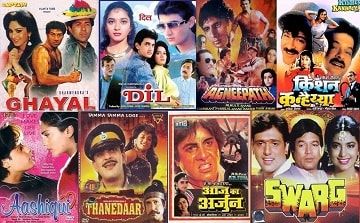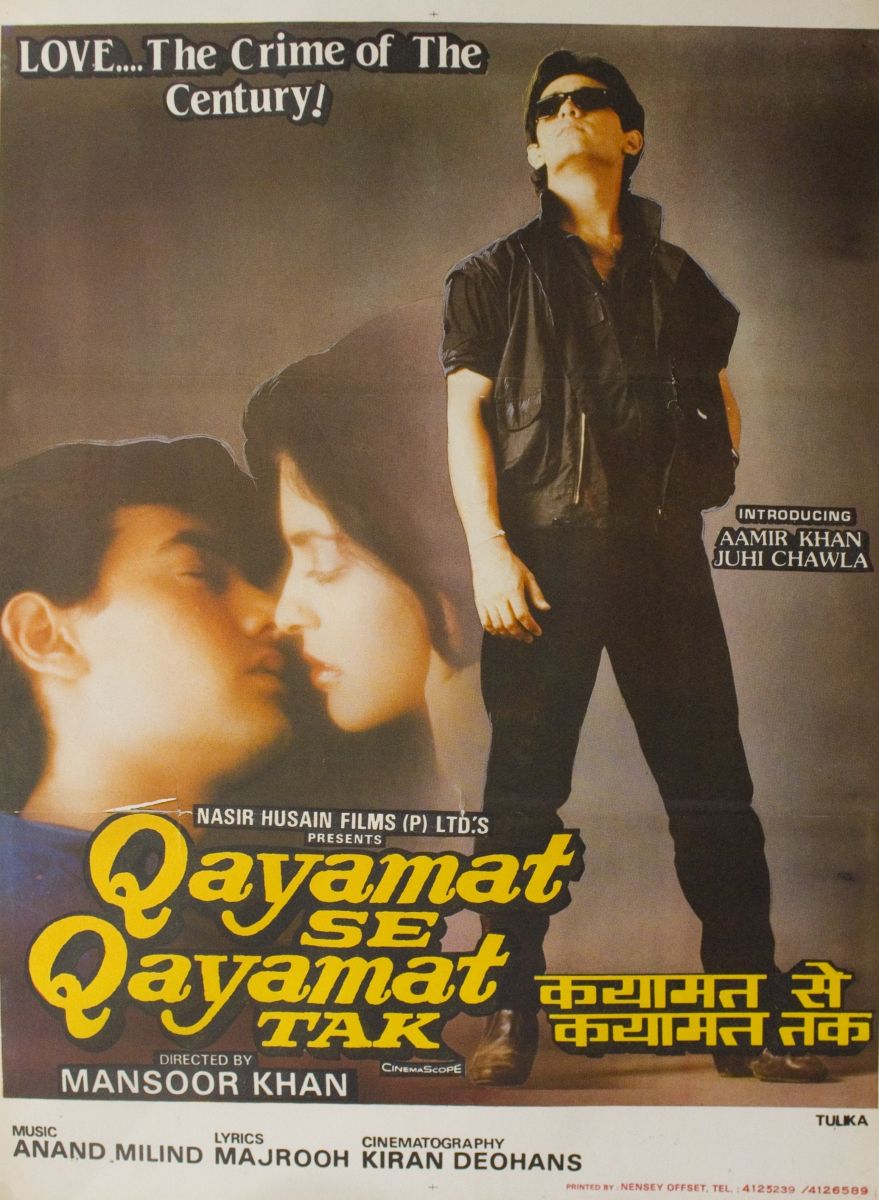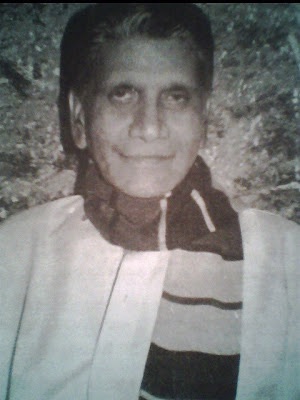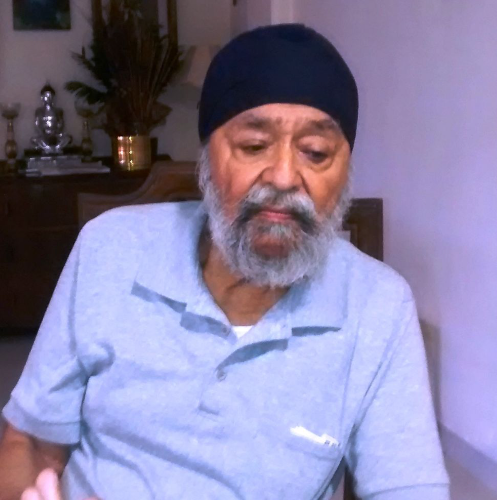Rewind 1990 Commerce of Love Stories
22 Jul, 2021 | Archival Reproductions by Cinemaazi

A compilation of film posters from 1990 Hindi films. Image courtesy: cinemazworld.com
An amorphous, blurringly-defined institution like the Hindi film industry cannot exist in a vacuum. Ironically the commerce of Hindi Cinema had to take a beating during the year as collections dipped.
This is a sad state of affairs considering that things were really looking up in an industry where speculations were ripe about its very survival with its superstar Amitabh Bachchan shedding glow, continuing video piracy and emergence of an alternate mass media, television.
The trend for calf love, with fresh faces cast in the romantic lead, was set by Quayamat se quayamat tak, a couple of years ago.
The trend for calf love, with fresh faces cast in the romantic lead, was set by Quayamat se quayamat tak, a couple of years ago.Towards the fag-end of 1989, Rajshree's Maine Pyar Kiya continued the winning phase for young romance by proving to be the biggest blockbuster of the decade, having netted Rs. 20 crores all over India. It used the four-track sound system for the first time in Indian films and also made waves with the new pair, Salman Khan and Bhagyashree. The heroine left to marry and settle down while the hero went on a signing spree, in the footsteps of his predecessor, Aamir Khan. Soon, the hit-parade was followed into the 1990s with fresh faces, or young faces when Dil, Ghayal et al became blockbusters. The one common thread running through many a hit this year is that all these films marked the directorial debut for its directors. Maine Pyar Kiya was directed by Suraj Kumar Barjatya; Dil, a romantic young-love story has Indra Kumar as its director; Ghayal has Rajkumar Santoshi at its directorial helm and Pratibandh has been directed by Ravi Raja. Sunil Agnihotri, a new director made a small-budget film called Danga Fasaad with new faces. It did extraordinary business, specially in Bombay. U.A. Thadani, a leading exhibitor, says: "it did stupendous business mainly because that video cassettes of the film were not in the market for one week after the release of the film".
G.P. Sippy comments: "more and more films with new stars are being launched. This is because the production costs have gone very high and the returns are diminishing. Today, there is no average film. Either the films do good business, or flop and do not even bring in the cost of production in prints and publicity. It is precisely because of this - to cut down the cost that I have launched Patthar Ke Phool with Salman Khan and Raveena Tandon so that the film can be made with reasonable investment, be a good entertainer and also recover a reasonable profit."
But Sippy does not believe that the love-story phase will last because he foresees the factor of audience-resistance to the same theme after a particular threshold has been crossed, as it has happened in the case of violence and revenge. Despite the unprecedented success of Ghayal and Pratibandh, many films on violence have bombed at the box office.
"But there is one pacifying thought. From the tremendous growth in the audio-market, a producer can easily expect Rs. 20 to Rs. 30 lakhs from the audio rights itself if the music alone becomes a hit" says Sippy.
Disco and popular music seem to have gone out of fashion and catchy tunes have caught the fancy of film lovers. Tezaab, Chandni, Maine Pyar Kiya, Ram Lakhan, Dil and Aashiqui have proved that music makes a film a hit.
Sippy's statement reasserts the return of the era of lilting, melodious music with QSQT. Disco and popular music seem to have gone out of fashion and catchy tunes have caught the fancy of film lovers. Tezaab, Chandni, Maine Pyar Kiya, Ram Lakhan, Dil and Aashiqui have proved that music makes a film a hit. The music has actually enhanced the repeat-value of these films, setting the trend since 1988 and continuing to rule the roost into the 1990s. The audio cassettes of Aashiqui have surpassed all records in sales. The music of the film is being dubbed in 18 languages which is by itself a record. Film music has rehabilitated the careers of struggling music directors like Raam Lakshman and Nadeem Shravan and Anand-Milind.
Technological innovation has come not only in the four-track sound system that necessitates the use of a wide, cinemascope screen, but also through the direct superimposing of images made possible with the same camera, according to technicians Hitendra Ghosh (sound) and Manmohan Singh (cinematography). But, "no technical value should be used as a gimmick" concludes Singh.
Looking at the grandeur of Maine Pyar Kiya, some theatre-owners have renovated their theatres by installing the four-track sound system at a time when exhibitors were thinking of bringing down the shutters.
What makes a film sell? "It is the film as a whole that runs, not the stars" says distributor Pahlaj Nihalani. "For example, before the release of Pratibandh, people thought Chiranjeevi will not be accepted by the Hindi audience. But the success of the film proved that it is not the stars who contribute to the success or the failure of a film but it is the film as a whole that succeeds or fails. Looking at the grandeur of Maine Pyar Kiya, some theatre-owners have renovated their theatres by installing the four-track sound system at a time when exhibitors were thinking of bringing down the shutters. Any Sunny Deol- starrer for Bombay alone fetches a net Rs. 30 lakhs. But for a new Sunny Deol film which has Shekhar Kapoor as director, the price has gone up to Rs. 50 lakhs which means that the director and the actor will determine the price of the film." This again means that the director is important as he decides the technical team and defines whether it will be lavishly mounted or modestly planned."Exhibitors have raised their rentals exorbitantly and this has affected the box office collections badly" says Gulshan Rai. "I feel that the distributors and the theatre owners should be allowed to deal directly with themselves instead of with a party charging brokerage" he concludes.
"But high rentals do not affect the box office value of a film if the film is really good" says Satpal Singh, a leading exhibitor. To substantiate his statement, he adds: "even when the ticket rates for Maine Pyar Kiya at Satyam in Bombay were hiked to Rs. 15/-, the film did good business and when NFDC's prize winning Panorama film Bagh Bahadur was released at tax-free ticket rates, there was no audience. People don't mind paying high ticket rates if the film is good."
U.A. Thadani, Pranlal Doshi and Russ Balaporia, leading exhibitors of Bombay, feel that video, cable TV and good TV programmes have taken their toll on the theatre collections. Besides, the electricity bills have gone up to Rs. 70,000 per month as against Rs. 30,000/- just a few years ago. And of the collections, say the exhibitors, they collect only 50 per cent and the remaining is taken away by the Government.

But the amount collected by way of entertainment tax by the Government of Maharastra spells a different story altogether. From its six districts, the State Government collected Rs. 64.52 crores in 1989-1990 of which Rs. 25.37 crores or 39.32 per cent came from Greater Bombay alone and the budgeted entertainment tax for the year 1990-91 is Rs. 70.16 crores. At the same time, there is no denying the fact that 69 cinemas have closed down in the State and a few handful have renovated their theatres and hiked their rates of admission.
"It is good and advance publicity that helps in the marketing of a film and helps in deciding its fate at the box office" says leading distributor Ramesh Sippy (not to be confused with director Ramesh Sippy). "Newspaper publicity is a must because it helps in building up a momentum and hits the mind of the audience" he adds.
"Publicity through trailers is also a good gimmick as these are audiovisual but since they are allowed release only a week before the actual release of the film, they do not help much. Radio publicity and previews should start at least two to three weeks before the film's release. Audio cassettes offer excellent publicity before the film's release. Take the example of Aashiqui. Today, a distributor can spend upto Rs. 5 lakhs just on the publicity of the film. After adding a song in Dil, we had to revive the publicity with "more money put in and it paid us right back" said Sippy.
Some of the new films which were to have been released but are being held back are - Farishtay, Ajooba, etc. Aaj Ke Shaenshah was also held back but has now been released. Producers I.A. Desai and Saleem Khan who decided to release Aaj Ke Sahenshah say: "there is no point in delaying the release of the film and further since our distributors are prepared to face the results."
"You will find a wide gap between the number of films made and the number of buyers available which means that the supply is more than the demand" say Desai and Ali. "They have become very choosy because of the dwindling returns and the flow of films in the market so they are after the best product. The presence of video and cable TV means the price of each film should be reasonably fixed in order to fetch a buyer" they conclude, adding that multistarrers still have a fair chance of doing well at the box office when compared to the box office expectations of small-budget films with a new cast, because they fetch buyers more easily than small-budget films.
"Studios have received a setback since bungalow-shooting became popular over the last ten years. Bungalows save time and money. And the single-shift system introduced last year (early this year?) has increased our margin of losses. Earlier, we suffered a loss of around Rs. 24 lakhs per year. Now it is much more" he says.
The picture among studio-owners is no less gloomy than elsewhere. Randhir Kapoor who is now looking after the of R.K. Studio, says: "Studios have received a setback since bungalow-shooting became popular over the last ten years. Bungalows save time and money. And the single-shift system introduced last year (early this year?) has increased our margin of losses. Earlier, we suffered a loss of around Rs. 24 lakhs per year. Now it is much more" he says.Tajdar Amrohi of Kamalistan Studios says: "one shift a day has reduced our business by 50 per cent. When there were three-four shifts a day, we had four to five bookings daily and now, the studios remain empty for at least 15 days a month." But Atmaram of Natraj Studios does not agree. "There has been no negative effect on the studio business because of the wide diversification of fields. We now have ad films and TV serials being shot in our studios and for lavish and large sets, directors still choose a studio." Tajdar adds that producers are now willing to compromise on the quality of a film by shooting in bungalows because today, the priority of money-making has over-ruled creativity. Most of the studio-owners today have inherited these studios from their parents and so, they keep the studios functioning more due to a feeling of family loyalty and homesickness than for making money.
Rajinder Singh, President of the Indian Film Exporters Association bemoans that the Gulf war and the unstable situation in the Middle East have brought down the earnings of the exporters of Indian films by 25 to 30 per cent.
The only bright silver lining is the 15 per cent hike in technicians' fees brought forth through a mutual compromise between the Film Makers' Combine and the Federation of Western Indian Cine Employees who luckily and surprisingly had Mithun Chakravarty pleading their cause!
The video market despite the piracy indulged in by the 15000 video libraries (which compulsorily have to buy the original cassettes of each film) and the home video distributors, has expanded to such an extent that the returns vary between Rs. 50 lakhs for an average film to over Rs. 1crore for a hit film. Video distributors are earning more than a crore on Amitabh starrers and some of them are making two different cassettes of the same film by adding or deleting a song sequence or a fight sequence. This has dealt a blow to the producers in the industry. They are forced to sell cable TV rights of their new films.
In this very funny industry where the hairdresser of a main star earns Rs. 10,000 per month and a technician after a hike of 15 per cent earns Rs. 230/- to Rs. 330/-, life can only be lived from moment to moment - in risk, in suspense, in drama, waiting for some miracle to happen at any time. And believe it or not, it does happen! Much like a Hindi film!
Statistics: (SCREEN TRADE INFORMATION)
The article was first published in the Indian Cinema 1990 issue. Images in the article have been taken from the Cinemaazi archive and the internet.
About the Author
Other Articles by Cinemaazi
17 Feb,2024
What is a Good Documentary Film?
25 Jan,2024
Salute to an Immortal Spirit
22 Jan,2024
A Painful Parting
29 Nov,2023
Children's Film Society
28 Oct,2023
Let's Give the Kids a Chance
26 Oct,2023
Directing the Child Actor
25 Oct,2023
Chandu - The Elephant Boy
23 Oct,2023
HEROISM-Children's Film Society gives the lead
18 Oct,2023
Munna
29 Sep,2023
ख्वाजा अहमद अब्बास का पत्र महात्मा गांधी के नाम
02 Sep,2023
Shakti Kapoor: It's Three Punches A Day
04 Jul,2023
Should a Filmmaker be Original?
24 Jun,2023
Babita My First Screen Love
22 Jun,2023
Phir Wohi Dil Laya Hoon
19 Jun,2023
Romance in Our Cinema
12 Jun,2023
The Romance of our Show Houses
12 Jun,2023
Kashmir Ki Kali (1964)
07 Jun,2023
Sangam (1964)
05 Jun,2023
This thing called Love
25 May,2023
Gandhi: Whose voice?
15 May,2023
"Deewar" Becomes a Nation's Prayer
15 May,2023
Mangal Pandey
06 May,2023
History of Cinema, History of the Nation
02 May,2023
Birbal Paristan Mein
20 Apr,2023
Reincarnation... the story goes on ever after
27 Mar,2023
The Film Director?
21 Mar,2023
M Sadiq
15 Mar,2023
The Social Role of the Cinema
15 Mar,2023
"Samaj" A Memorable Film with Popular Appeal
01 Mar,2023
"Two Eyes" in Hollywood
20 Feb,2023
Do Dooni Chaar
15 Feb,2023
Rafoo Chakkar
07 Feb,2023
Johnny Walker.... still going strong
20 Jan,2023
Mahabharat : Epic Tamasha
10 Jan,2023
Narsi Bhagat : An Excellent Biography
03 Jan,2023
Nav Ratri
01 Dec,2022
एक ताजगी का नाम है देवानन्द (Dev Anand)
25 Nov,2022
जे बी एच वाडिया (J B H Wadia) - वचन न जाए
14 Nov,2022
Children's Films in India
01 Sep,2022
Horses .... Cars and Laughs-Mehmood
06 Aug,2022
हिन्दी फिल्मों की दुर्दशा का जिम्मेदार कौन?
01 Aug,2022
क्या हिंदी फिल्मों से हास्य गायब हो रहा है?
20 Jul,2022
हास्य की परंपरा और हास्य अभिनेताओं की भूमिका
12 Jul,2022
प्राण और उनकी दाढ़ियाँ
17 Feb,2022
Odds Against a New Comer
10 Dec,2021
Speaking of Portraits and People
03 Nov,2021
An Actor Prepares
19 Oct,2021
Producers' War on Dubbed Films
24 Aug,2021
Jottings from a Film Director's Notebook
26 Jul,2021
प्रेमचंद सत्यजीत राय और ’सद्गति’ -गिरिजाशंकर
20 Jul,2021
Eastern Scene: Cinema of Surviving Faith
22 Jun,2021
Movie Memories : Tansen (1943)
22 Jun,2021
Movie Memories: Sikandar (1941)
15 Jun,2021
Towards A Brighter Future- Bengali Cinema
20 May,2021
The Enigma Of A Flux - Malayalam Cinema
05 May,2021
The seesaw graph of Hindi filmdom
03 May,2021
Ankahee: The Unspoken
29 Apr,2021
The Mahatma Returns: World Press Reaction
29 Apr,2021
Children’s Films
17 Apr,2021
Telugu Cinema in 1986- Sons and Fathers
09 Apr,2021
Mukhamukham : Face to Face
08 Apr,2021
Tarang : Wages and Profits
01 Apr,2021
Design In Indian Cinema
27 Mar,2021
Movie Memories : Savkari Pash
23 Mar,2021
Double Trouble: Role of Twins In Hindi Cinema
22 Mar,2021
Prem Chopra: The Same Role For Ever
19 Mar,2021
Kalyan Kumar - Karnataka’s Self-Made Star
18 Mar,2021
Ceylon's Cyclonic Cinema
18 Mar,2021
Movie Memories : Aladdin & the Wonderful Lamp
17 Mar,2021
Kumari Padmini: Rising New Star Of The South
11 Mar,2021
50 YEARS OF MALAYALAM CINEMA
02 Mar,2021
Alakh Niranjan: Film India Review
27 Feb,2021
Party: The Story of Choices
26 Feb,2021
The Naushad Era In Hindi Film Music
19 Feb,2021
A Man: Amitabh Bachchan -Amitabh, is My Name
10 Feb,2021
A Man: Amitabh Bachchan - Two of a Kind
29 Jan,2021
Women In Hindi Films : Dichotomy of Values
22 Jan,2021
A Man: Amitabh Bachchan - Yesterday and Tomorrow
22 Jan,2021
Cinema in the South: Crisis of Character
18 Jan,2021
Film Societies Play Their Part
01 Jan,2021
Nutan : A Flashback - The Actress
30 Dec,2020
"Gwalan" Proves A Thrilling Entertainment !
29 Dec,2020
Rajesh Khanna : Echoes Of An Era- Family Of Four
28 Dec,2020
Holi: A Metaphor for Horizontal Violence
23 Dec,2020
A Summon for Mohan Joshi
22 Dec,2020
Nutan : A Flashback - The Friend
22 Dec,2020
Raj Kapoor Scores Personal Triumph In “Aag”!
19 Dec,2020
Smita Patil's Memoir- Trading Places
17 Dec,2020
Shashi Kapoor: Once Upon A Time- The Film Makers
16 Dec,2020
Rajesh Khanna : Echoes Of An Era- Peer Pressures
15 Dec,2020
“Lal Haveli”- Crude But Entertaining!
12 Dec,2020
Nutan : A Flashback - The Wife
10 Dec,2020
Rajesh Khanna : Echoes Of An Era
09 Dec,2020
"Lalkar" Presents Cheap Entertainment
07 Dec,2020
Smita Patil's Memoir-Comrades In Arms
01 Dec,2020
Shashi Kapoor: Once Upon A Time- Unjinxed
28 Nov,2020
Ek Din Ka Sultan- Becomes Good Entertainer !
26 Nov,2020
Smita Patil's Memoir- Friendly Strokes
25 Nov,2020
Shashi Kapoor: Once Upon A Time- Tough Times
07 Nov,2020
The Technician And His Problems
06 Nov,2020
We Must Inject Dynamism Into Publicity
05 Nov,2020
The Role Of Film Finance Corporation
04 Nov,2020
Progress In Raw Film
30 Oct,2020
Freedom In Films
28 Oct,2020
Export Market For Indian Films
23 Oct,2020
The Growth of The Motion Picture
22 Oct,2020
Setup Of The Film Industry
21 Oct,2020
Few Facts About Film Production
13 Oct,2020
Personalisation In Cinema
08 Oct,2020
Waiting for a Doyen's Glance- Arati Bhattacharya
08 Oct,2020
कौन सुनेगा इन सिसकती बिलखती प्रतिभाओं का विलाप?
06 Oct,2020
Asrani - Laugh And The World Laughs With You
05 Oct,2020
My Memorable Roles- Hiralal
03 Oct,2020
राजीव गोस्वामी - कहां थे अब तक 'पेंटर बाबू'?
03 Oct,2020
जब नफरत से बेड़ा पार हो गया: बलराज साहनी
30 Sep,2020
The Case of Emotional Turmoil In Dopatta (1952)
29 Sep,2020
The Story Of A Child Artiste - Sheela Kashimiri
26 Sep,2020
Afsana Likh Rahi Hoon : Tun Tun
26 Sep,2020
Some Hopes For The New Year: Lillian
24 Sep,2020
Joru Ka Bhai: A Tale of 'Atithi Tum Kab Jaoge'
22 Sep,2020
अभिनेता प्रेमअदीब से भेंट
21 Sep,2020
Vijaylaxmi: A Career As The 'Other' Woman
18 Sep,2020
Shaminder: The Actor Who Had High Hopes
16 Sep,2020
धर्मेन्द्र - समय आ रहा है...
14 Sep,2020
Film Life After Fifty : Motilal
14 Sep,2020
प्रसिद्ध फिल्म लेखक गुलशन नंदा से आपकी बातचीत
11 Sep,2020
"I live on hope"- Kumkum
11 Sep,2020
Thehr Zara O Jane Wale : Madhubala Jhaveri
09 Sep,2020
Ratnamala Attracts Attention In ‘Station Master’
08 Sep,2020
Ghory: The Laurel Of Indian Cinema's Comedy Duo
07 Sep,2020
Yeh Teri Saadgi, Yeh Tera Baankpan: Usha Khanna
07 Sep,2020
सेनापति शेट्टी
05 Sep,2020
कृतिदेव यहां मैं, तनूजा, स्वीकार करती हूँ
05 Sep,2020
मै उर्मिला को भूल नहीं पाती - मंजरी
04 Sep,2020
बुलबुल बंगाल की: चंद्राणी मुखर्जी
03 Sep,2020
Payyal's Lucky Break
02 Sep,2020
These Foreign Producers
29 Aug,2020
The Practical Actress: Shabnam
29 Aug,2020
“Amrit” Becomes A First Class Picture
28 Aug,2020
फिल्मी मारपीट के गुरू : अजीम भाई
26 Aug,2020
From Poverty to Screen Fame - Mehboob Khan
26 Aug,2020
Humility: Nasreen's Most Admirable Feature
24 Aug,2020
A Mercenary Comes To India - Bob Christo
23 Aug,2020
Dilip Kumar: The Leader
19 Aug,2020
Alam Ara: Ardeshir Irani's Ambitious Secret
17 Aug,2020
I Serve My Art- Kanan Devi
10 Jul,2020






.jpg)


